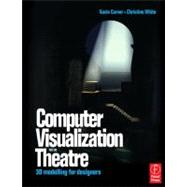
Note: Supplemental materials are not guaranteed with Rental or Used book purchases.
Purchase Benefits
Looking to rent a book? Rent Computer Visualization for the Theatre: 3D Modelling for Designers [ISBN: 9780240516172] for the semester, quarter, and short term or search our site for other textbooks by Carver; Gavin. Renting a textbook can save you up to 90% from the cost of buying.
| Introduction | ix | ||||
| How to use this book | ix | ||||
| 1 Setting the scene: contexts and approaches | 1 | (12) | |||
|
1 | (2) | |||
|
3 | (1) | |||
|
4 | (5) | |||
|
9 | (4) | |||
| 2 Outlining the software and its development | 13 | (13) | |||
|
13 | (1) | |||
|
13 | (3) | |||
|
16 | (3) | |||
|
19 | (4) | |||
|
23 | (3) | |||
| 3 Thinking about the hardware: an overview of relevant technologies | 26 | (15) | |||
|
26 | (3) | |||
|
29 | (4) | |||
|
33 | (5) | |||
|
38 | (3) | |||
| 4 Navigating the computer space | 41 | (15) | |||
|
41 | (2) | |||
|
43 | (1) | |||
|
44 | (3) | |||
|
47 | (1) | |||
|
48 | (2) | |||
|
50 | (1) | |||
|
51 | (1) | |||
|
52 | (1) | |||
|
53 | (3) | |||
| 5 The basics of modelling | 56 | (31) | |||
|
57 | (4) | |||
|
61 | (3) | |||
|
64 | (2) | |||
|
66 | (2) | |||
|
68 | (2) | |||
|
70 | (1) | |||
|
71 | (1) | |||
|
71 | (5) | |||
|
76 | (2) | |||
|
78 | (6) | |||
|
84 | (3) | |||
| 6 The basics of materials | 87 | (26) | |||
|
88 | (1) | |||
|
89 | (18) | |||
|
107 | (6) | |||
| 7 The basics of lighting | 113 | (26) | |||
|
114 | (4) | |||
|
118 | (9) | |||
|
127 | (5) | |||
|
132 | (4) | |||
|
136 | (3) | |||
| 8 The rule of change - scenographic improvisation | 139 | (4) | |||
| 9 Peopling the stage | 143 | (8) | |||
|
143 | (1) | |||
|
144 | (6) | |||
|
150 | (1) | |||
| 10 Composition, cameras, rendering and resolution | 151 | (9) | |||
|
152 | (3) | |||
|
155 | (1) | |||
|
156 | (1) | |||
|
157 | (3) | |||
| 11 Advanced modelling | 160 | (13) | |||
|
160 | (6) | |||
|
166 | (4) | |||
|
170 | (2) | |||
|
172 | (1) | |||
| 12 The design over time: storyboards and animations | 173 | (13) | |||
|
173 | (1) | |||
|
173 | (3) | |||
|
176 | (8) | |||
|
184 | (2) | |||
| 13 Project management | 186 | (24) | |||
|
186 | (1) | |||
|
187 | (3) | |||
|
190 | (3) | |||
|
193 | (5) | |||
|
198 | (4) | |||
|
202 | (8) | |||
| 14 Conclusion | 210 | (3) | |||
| Bibliography | 213 | (6) | |||
| Glossary | 219 | (4) | |||
| Index | 223 |
The New copy of this book will include any supplemental materials advertised. Please check the title of the book to determine if it should include any access cards, study guides, lab manuals, CDs, etc.
The Used, Rental and eBook copies of this book are not guaranteed to include any supplemental materials. Typically, only the book itself is included. This is true even if the title states it includes any access cards, study guides, lab manuals, CDs, etc.